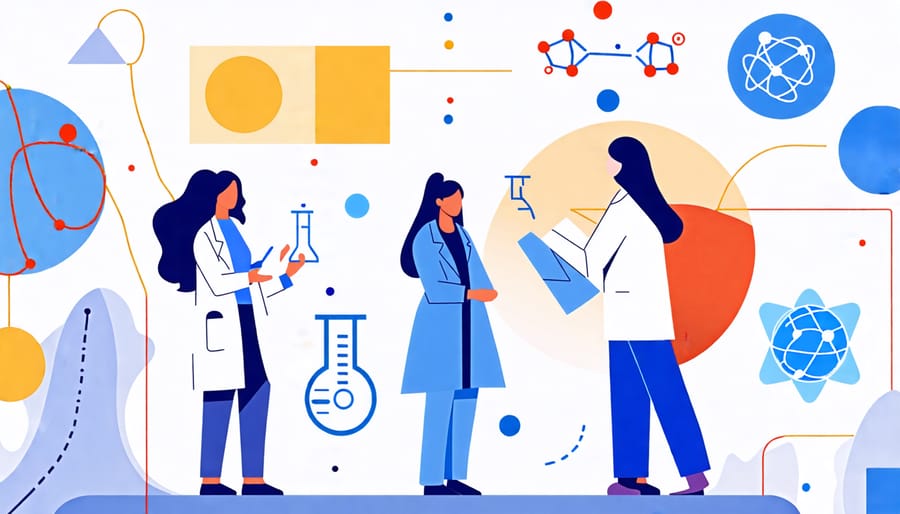Harness the power of collaborative initiatives to drive groundbreaking advancements in science and education. Foster interdisciplinary research by forming strategic partnerships with universities and colleges to expand resources and expertise. Engage in open data sharing and cross-institutional projects that leverage diverse perspectives to solve complex challenges in Earth Sciences and Physics. Promote real-world applications by integrating collaborative findings into educational curriculums, enhancing both teaching methods and student outcomes. Highlight success stories and best practices from leading researchers, inspiring others to participate actively in collaborative projects.
Understanding Collaborative Initiatives

Defining Collaborative Initiatives
Collaborative initiatives are the heart of modern scientific progress, acting as a powerful engine that drives innovation and discovery. These initiatives involve a coordinated effort among scientists, researchers, educators, and institutions, aiming to tackle complex problems that surpass the scope of individual efforts. As explained by Dr. Lisa Taylor, a leading physicist, “Collaboration allows us to leverage diverse expertise and resources, paving the way for breakthroughs that would be unattainable in isolation.” One striking example is the Human Genome Project, a global collaborative effort that unlocked new dimensions in genetics and medicine. In Earth Sciences, international collaborations are crucial in understanding climate change, where shared data and insights lead to more comprehensive climate models. Similarly, in Physics, projects like CERN involve thousands of researchers from around the world working together to explore the fundamental particles of the universe. Through these partnerships, the scientific community can address global challenges more effectively, enhancing research outcomes and fostering educational advancement across disciplines.
The Role in Education and Research
Collaborative initiatives serve as a catalyst for interdisciplinary education and research by seamlessly bridging the gaps between diverse fields and institutions. In the dynamic world of science and technology, this approach empowers researchers and students to tackle complex problems that no single discipline can solve alone. For instance, Earth Sciences and Physics teams are joining forces to enhance climate change models, blending geological data with advanced physical simulations. Such partnerships pave the way for groundbreaking discoveries and innovations. Notably, universities and colleges play a pivotal role in these endeavors by facilitating knowledge exchange and resource sharing. According to Dr. Emily Carter, a leading researcher in sustainable energy, “By collaborating across disciplines, we unlock the potential for revolutionary advancements that benefit society as a whole.” These initiatives not only enhance academic curricula but also offer real-world applications, equipping learners with the skills needed to address global challenges. As these collaborations continue to flourish, they promise an era of educational and scientific growth, fostering a brighter future through shared expertise and vision.
Case Studies in Earth Sciences and Physics
Earth Sciences: Monitoring Climate Change
One shining example of a collaborative project aimed at understanding and addressing climate change is the multinational effort known as the Global Carbon Project (GCP). This project unites researchers worldwide to study the carbon cycle and elaborate a comprehensive understanding of its role in climate change. By pooling resources and knowledge, the GCP enhances our ability to predict and mitigate climate change impacts. Dr. Anna Stevens, a leading scientist in the project, highlights the collaboration’s significance: “Our work makes it possible to improve models and trends in carbon emissions and uptake, which are crucial for developing effective policy measures.” A real-world application of their research is assisting policymakers in creating more accurate emission reductions and carbon management strategies. The collaborative nature of this initiative also fosters knowledge exchange among nations, empowering regions with fewer resources to engage effectively with climate issues. Professor Carl Henrik, another researcher involved, shares, “This collaboration bridges gaps between data and action, enabling countries to tailor their approaches based on reliable scientific findings.” The GCP exemplifies how science transcends borders, with researchers working hand-in-hand to address one of the most pressing challenges of our time: climate change. Through such initiatives, the collective scientific community brings not just optimism but tangible solutions to global audiences, enhancing our preparedness for future environmental shifts and impacts.

Physics: Advancements in Quantum Computing
In a landscape rapidly transforming through collaborative innovation, the realm of quantum computing has surged forward, unlocking new potentials and practical applications. A stellar example is the coming together of leading minds from around the globe, exemplified by the recent quantum computing breakthroughs. Researchers from the University of Copenhagen, pooling their expertise, have achieved dramatic strides in quantum advantage, marking a pivotal moment in computational history. This collaborative initiative has manifested tangible impacts beyond the academic sphere. Consider the advancement of encryption technologies, where quantum computing is revolutionizing cybersecurity. By cracking codes in mere seconds, these breakthroughs suddenly turn previously daunting security challenges into manageable tasks. Moreover, sectors like drug discovery are looking at quantum algorithms to expedite molecular simulations, significantly abbreviating the timeline for discovering new medications. Dr. Lise Johnson, a leading researcher involved in the initiative, emphasizes, “This collaboration propels us closer to answering questions we once deemed impossible.” Such insights, born from diverse expertise, have facilitated a fertile ground where theoretical physics intertwines with real-world applications, reshaping industries across the board. As these partnerships burgeon, the promise of quantum computing in everyday life becomes more than a futuristic dream; it becomes a dynamic reality shaping the modern technological landscape.

The Role of Universities and Colleges
Universities and colleges are at the heart of the vibrant ecosystem of scientific collaboration and innovation. By acting as hubs for knowledge exchange and interdisciplinary research, these institutions are crucial in driving groundbreaking advancements that ripple across various fields. Through dedicated faculty members and committed researchers, they provide a fertile ground for nurturing the ideas that fuel scientific progress. An integral part of their mission involves preparing future scientists to tackle complex global challenges by fostering a spirit of inquisitiveness and resilience among their students. Programs and initiatives within these educational institutions are actively transforming science education. For instance, many universities have embraced collaborations with industry leaders and government agencies, ensuring students receive hands-on experience with cutting-edge technologies and methodologies. A notable example can be seen in the partnerships between academic departments of Earth Sciences and national meteorological services, which not only enhance research but also provide real-world applications that bolster environmental policy-making. University researchers, such as Dr. Emily Carter from Princeton University, often emphasize the dual necessity of technical knowledge and visionary thinking. She remarks, “In our labs, students are encouraged to question norms and explore unconventional solutions.” Such educational environments are instrumental in producing adept scientists who are well-equipped to innovate and influence. Furthermore, research conducted in university settings frequently leads to technological breakthroughs that enter the commercial sphere, showcasing the invaluable symbiosis between academic inquiry and industrial application. As students graduate and join the workforce, they carry with them the values of collaboration and innovation, ensuring that the legacy of their education perpetuates the cycle of scientific advancement. In essence, universities and colleges not only groom the leaders of tomorrow but also continually contribute to the evolving narrative of scientific discovery.
Challenges and Opportunities
Overcoming Barriers
Overcoming the barriers to successful collaboration in science and technology requires identifying key obstacles such as communication gaps, differing priorities, and cultural differences. Without clear communication, researchers might fall prey to misunderstandings that stall progress. To bridge these gaps, fostering an environment where dialogue is encouraged can be transformative. Dr. Jane Goodman, a leading researcher in collaborative innovation, emphasizes, “Regular interdisciplinary meetings create shared understanding and align goals.” Differing priorities pose another challenge, particularly when academia and industry intersect. Prioritizing shared objectives and demonstrating mutual benefits can help align these interests. In real-world applications, successful collaborations are often those where partners remain flexible yet focused on the end goal. In initiatives like the Harvard-Aachen collaboration, diverse teams have forged paths to groundbreaking advancements by emphasizing shared values and respect for each team’s contributions, illustrating the immense potential when barriers are thoughtfully addressed.
Future Opportunities
The future of collaborative initiatives is brimming with potential, particularly as scientific communities increasingly embrace a multidisciplinary approach. As Dr. Mia Taylor, a leading expert in collaborative research, said, “The fusion of diverse perspectives drives innovation.” This collective creativity is set to tackle complex global challenges, such as climate change through joint Earth Sciences projects, enabling breakthroughs in sustainable technology development. Additionally, partnerships between universities, private sectors, and research institutions promise significant advancements in quantum computing, which could revolutionize data processing and security. Real-world applications, like shared global databases for pandemic response and smart city solutions, exemplify how collaborative efforts are laying the groundwork for technological and scientific evolution. Looking ahead, such initiatives are not only expected to accelerate discovery but also ensure that knowledge benefits a broader segment of society.

